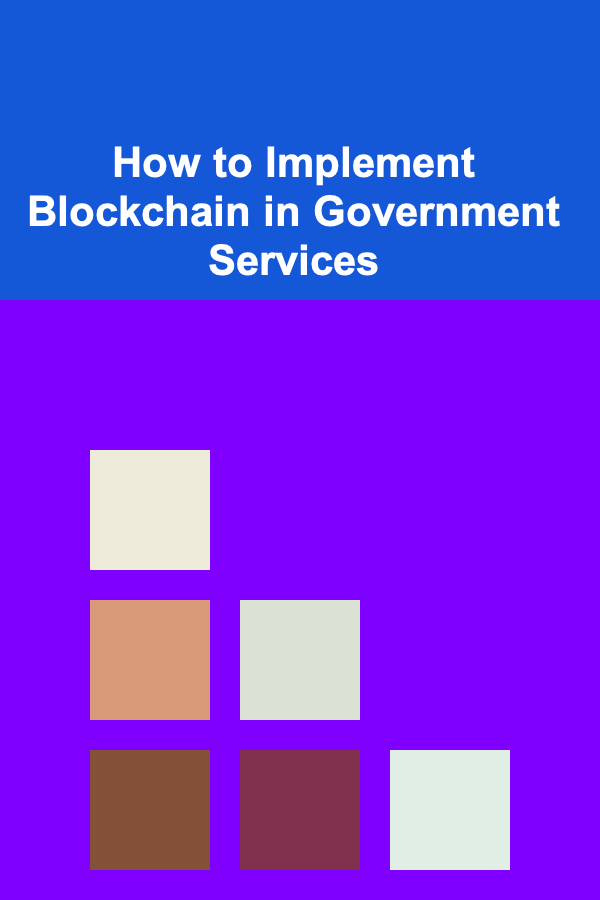
How to Implement Blockchain in Government Services
ebook include PDF & Audio bundle (Micro Guide)
$12.99$5.99
Limited Time Offer! Order within the next:

Blockchain technology has emerged as one of the most significant technological innovations in recent years, providing new ways to manage and share data securely, transparently, and efficiently. Originally developed as the underlying technology for cryptocurrencies like Bitcoin, blockchain's potential applications extend far beyond digital currencies. One of the most promising areas for blockchain implementation is government services. From ensuring secure voting systems to enhancing public records management and improving government transparency, blockchain can revolutionize the way governments operate. This article explores how to implement blockchain in government services, highlighting its potential benefits, challenges, and practical steps for adoption.
What is Blockchain?
At its core, blockchain is a decentralized and distributed digital ledger that records transactions across multiple computers in such a way that the registered transactions cannot be altered retroactively. This makes blockchain an incredibly secure and transparent method for managing and recording data. Unlike traditional centralized databases, blockchain operates on a peer-to-peer network where each participant (or node) has an identical copy of the ledger, ensuring greater security and trust in the system.
Blockchain is comprised of "blocks" of data, each containing a list of transactions. These blocks are linked together in a "chain," with each new block containing a cryptographic reference to the previous block, making it nearly impossible to alter past records without detection.
Why Blockchain is a Game-Changer for Government Services
Governments are responsible for managing vast amounts of data, from tax records and social security information to public health records and voting data. However, managing these records using traditional systems often leads to inefficiencies, vulnerabilities to fraud, and lack of transparency. Blockchain technology addresses many of these challenges by offering several benefits that are particularly valuable for government services:
1. Transparency and Accountability
One of the most powerful features of blockchain is its transparency. Every transaction recorded on a blockchain is visible to all participants in the network, creating a level of transparency that is unparalleled. This could significantly reduce corruption and fraud within government services, as citizens would be able to track the movement of public funds, contracts, and decisions in real-time.
For example, in public procurement processes, blockchain could provide an immutable record of all bids, contracts, and payments. This would help prevent manipulation, favoritism, or bribery, and would allow citizens to hold the government accountable for its actions.
2. Enhanced Security
Blockchain provides a high level of security because it is decentralized and each transaction is cryptographically secured. Once a block is added to the blockchain, it is nearly impossible to alter, which makes it a highly effective tool for preventing data tampering or cyberattacks. For government services, this could be crucial in protecting sensitive data, such as personal identification information, voting data, and health records, from being hacked or altered.
Additionally, blockchain's ability to ensure data integrity means that public sector organizations can have more confidence in the accuracy and authenticity of the data they rely on.
3. Efficiency and Cost-Reduction
Government services often involve a significant amount of paperwork, intermediaries, and manual processes, which can result in inefficiencies and high administrative costs. Blockchain can streamline many of these processes by automating tasks, reducing the need for intermediaries, and providing a more efficient way to store and manage data.
For example, blockchain can be used to automate government payment systems, ensuring faster and more secure disbursement of funds, or to manage the issuance of digital IDs, reducing the need for physical documentation and improving access to government services.
4. Improved Trust Between Citizens and Government
Blockchain's ability to provide secure and transparent records can help rebuild trust between citizens and the government. Citizens may feel more confident that their personal information is being handled securely and that government processes are fair and transparent. By implementing blockchain, governments can show their commitment to transparency and accountability, which is essential for fostering trust in public institutions.
5. Decentralization and Autonomy
Blockchain's decentralized nature means that there is no central authority controlling the network, which reduces the risk of single points of failure. In the context of government services, decentralization could lead to a more distributed and efficient system for managing data, making it harder for malicious actors or hackers to compromise the entire system. It also allows for greater autonomy for citizens, as they would have control over their own personal data and transactions, rather than relying on centralized government databases.
Key Areas for Blockchain Implementation in Government Services
Blockchain has a wide range of potential applications within government services. Below are some of the most promising areas where blockchain can be applied.
1. Digital Identity and Authentication
One of the most important areas for blockchain implementation is digital identity management. Many governments around the world have struggled with efficiently managing citizens' identities while ensuring privacy and security. Blockchain can help streamline this process by providing a decentralized and immutable record of each citizen's identity.
Through the use of digital IDs, blockchain can facilitate secure authentication for accessing government services, voting, and public healthcare. Citizens would have full control over their identity and personal information, and they would be able to verify their identity without relying on third parties or cumbersome bureaucratic processes. This could also reduce fraud and identity theft.
2. Voting Systems
One of the most exciting possibilities for blockchain is its potential to revolutionize voting systems. Voting is a critical aspect of democracy, but traditional voting systems are often subject to fraud, manipulation, and inefficiencies. Blockchain can provide a secure, transparent, and tamper-proof voting system where each vote is securely recorded on a decentralized ledger.
By using blockchain, governments could ensure that votes are securely transmitted and counted, and citizens could verify that their vote was accurately recorded. This could increase trust in electoral processes and reduce the risk of election tampering. Additionally, blockchain voting could enable more convenient and accessible voting methods, such as remote voting, making it easier for citizens to participate in the democratic process.
3. Public Records and Land Registration
Public records, including land ownership, property titles, and legal documents, are typically stored in centralized databases that are vulnerable to corruption, fraud, and data loss. Blockchain can provide a decentralized, transparent, and immutable solution for managing public records.
In the case of land registration, blockchain could offer a secure and transparent system for tracking property ownership and transfers. Each transaction (e.g., buying or selling a property) could be recorded on the blockchain, creating a permanent, tamper-proof record that is easily accessible to all parties involved. This would not only enhance transparency but also reduce the potential for disputes over property ownership.
4. Public Procurement and Supply Chain Management
Governments are major participants in procurement and supply chain activities, and these processes often suffer from inefficiencies, corruption, and a lack of transparency. Blockchain can help by providing an immutable record of all transactions, from bidding to contract execution to payment.
By using blockchain, governments can track the entire lifecycle of a procurement process, ensuring that all steps are transparent and that funds are used as intended. This could help eliminate fraud, reduce corruption, and increase the efficiency of government procurement.
5. Healthcare and Medical Records
Healthcare data is some of the most sensitive information handled by government agencies, and ensuring its security and privacy is paramount. Blockchain can offer a solution for securely storing and sharing medical records, enabling patients to have more control over their own data.
By using blockchain, medical records could be stored in a decentralized ledger that is accessible only to authorized medical professionals and patients themselves. This would ensure that patient data is secure, tamper-proof, and accessible in real-time, improving healthcare delivery and reducing administrative overhead.
Challenges of Implementing Blockchain in Government Services
While the potential benefits of blockchain are significant, there are also several challenges associated with its implementation in government services. Some of these challenges include:
1. Regulatory and Legal Framework
The adoption of blockchain in government services requires a supportive regulatory and legal framework. Governments must establish clear guidelines and standards for blockchain use, particularly in areas like digital identity management, voting, and data privacy. This could be a complex process, as blockchain technology is still relatively new and evolving.
2. Interoperability and Integration
Governments typically use a variety of legacy systems to manage data, and integrating blockchain with these existing systems can be challenging. Ensuring that blockchain can work seamlessly with current government databases and processes is essential for successful implementation.
3. Public Perception and Trust
While blockchain has the potential to improve transparency and security, many people are still unfamiliar with the technology and may have concerns about its implementation. Governments will need to invest in public education and awareness campaigns to ensure that citizens understand the benefits and security of blockchain-based systems.
4. Scalability and Performance
Blockchain networks, particularly those using proof-of-work consensus mechanisms, can be resource-intensive and slow. Governments will need to ensure that blockchain systems can handle the volume of data and transactions typically processed by public sector organizations. Solutions like proof-of-stake and sharding may help improve blockchain's scalability, but these technologies are still developing.
5. Data Privacy and Security
While blockchain is secure by design, the implementation of privacy features is still a work in progress. Governments will need to find ways to ensure that sensitive data is kept private, particularly in areas like healthcare and voting. Techniques such as zero-knowledge proofs and private blockchains may be useful in this regard, but their adoption requires careful consideration of privacy laws and regulations.
Conclusion
Blockchain technology has the potential to revolutionize government services by increasing transparency, enhancing security, and improving efficiency. By implementing blockchain in key areas such as digital identity management, voting systems, public records, and procurement, governments can create more trustworthy and efficient systems that benefit both citizens and public institutions. However, successful implementation will require addressing challenges such as regulatory frameworks, interoperability with legacy systems, and scalability. As the technology continues to mature, blockchain's role in transforming government services will only become more pronounced, leading to a more transparent, secure, and efficient public sector.

How to Build a Healthy Gaming Lifestyle
Read More
How to Create a Study Space That Promotes Focus
Read More
How to Design a Functional and Space-Efficient Mudroom
Read More
How to Make the Most of Limited Trunk Space
Read More
How to Market Your Home Music Lessons to Local Students
Read More
How to Master Active Listening Skills
Read MoreOther Products

How to Build a Healthy Gaming Lifestyle
Read More
How to Create a Study Space That Promotes Focus
Read More
How to Design a Functional and Space-Efficient Mudroom
Read More
How to Make the Most of Limited Trunk Space
Read More
How to Market Your Home Music Lessons to Local Students
Read More